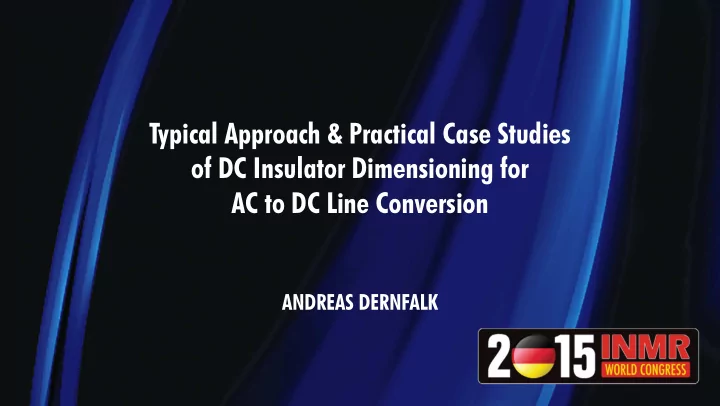

Typical Approach & Practical Case Studies of DC Insulator Dimensioning for AC to DC Line Conversion ANDREAS DERNFALK
Typical Approach & Practical Case Studies of DC Insulator Dimensioning for AC to DC Line Conversion Andreas Dernfalk Jan Lundquist Igor Gutman 1
Very few data available 12 STRI involved projects / 3 published (2007-2015) 2
Recent CIGRE TB 583 3
Introduction + Potential major gain in capacity (no stability constraints and comparatively high voltage levels) + Short lead times compared to building new lines + Support of AC system from VSCs - Cost of converter stations - Requirements on DC insulators in polluted areas 4
Case examples 1(3) Parameter Line A Line B Line C Line D Line E Voltage 132 kV 220 kV 220 kV 400 kV 400 kV Phase conductor 26,7 mm 36,2 mm 21,6 mm 32,9 mm 31,7 mm diameter Number of 1 1 2 3 2 or 3 subconductors Subconductor - - 450 mm 450 mm 450 mm spacing Phase spacing 5,2 m 10,0 m 6,85 m 9,1 m 9,0 m Insulator type 10xU80 10xU160BLP 12xU120 21xU160BS 16xU210 Insulation length 1,300 m 1,700 m 1,752 m 3,066 m 2,720 m Maximum conductor 40 ° C 40 ° C 70 ° C 80 ° C 50 ° C temperature 5
Case examples 2(3) Line A, 132 kV Line B, 220 kV Line C, 220 kV 6
Case examples 3(3) Line D, 400 kV Line E, 400 kV 7
Evaluation of conversion options • Maximum thermal power capacity • Maximum DC voltage determined by • Required insulator length • Required conductor clearance to ground • Recommended corona and field effect limits • Maximum DC current determined by • Maximum allowed conductor temperature • Required conductor clearance to ground 8
Insulator dimensioning • Replacement of existing cap&pin insulators • Corrosion under DC voltage • Ion migration • Pollution flashover performance • Optimal use of available space • Statistical method for dimensioning • Composite insulators 9
Statistical dimensioning Environment Insulator Selection Tool - IST Insulator type Number of insulators 10
Pollution severity along line routes • ESDD under AC estimated based on • Environmental descriptions – IEC 60815 • Design of existing AC lines – IEC 60815 • Statistical evaluation of existing AC lines (IST) • ESDD under DC estimated according to Cigré TB 518 (based on ESDD under AC) 11
Required DC insulator length • Length calculated for using IST • Estimated ESDD under DC • NSDD = 0,1 mg/cm 2 • No. of pollution events • No. of insulators in parallel • Acceptable MTBF = 20 years/pole Required insulator length, (m/100 kV DC) Insulator type Type A Type B Type C Type D Type E 132 kV 220 kV 220 kV 400 kV 400 kV Cigré DC 1,41 0,85 0,83 0,83 0,82 composite 12
Corona and field effects • Audible noise • Highest levels in fair weather • Maximum recommended 50% level is 40 dBA • Calculated 50% level in fair weather using the BPA formula • Electric field and ion current • No induction effects (not harmful but annoying) • Maximum recommended levels 25-40 kV/m / 100 nA/m² • Calculated 10% levels in fair weather and no-wind conditions using the AnyPole program • Radio interference • Corona loss 13
Optimal line configurations for conversion to DC • Constraints on DC voltage and current: • Maximum allowable conductor temperature • Required insulator length • Required ground clearance • Recommended limits on corona and field effects (audible noise, E- field and ion current density…) • Calculation of maximum DC power capacity under the above constraints • Comparison with thermal capacity of existing AC lines 14
Attainable capacities Maximum Conductor Total Voltage level power Line Operation temperature capacity (kV) capacity ( ° C) increase (%) (MW) AC 135 40 150 A 93 DC ± 140 80 290 AC 230 40 390 B 144 DC ± 300 80 950 AC 230 70 390 C 62 DC ± 250 80 630 AC 410 80 2090 D 9 DC ± 350 80 2270 AC 410 50 600 E, twin bundle 142 DC ± 350 80 1450 AC 410 50 900 E, tripple bundle 176 DC ± 400 80 2480 15
Cost per tower Estimates based on modification of 1000 towers Labour cost Equipment cost Material cost Total cost Tower type (EUR) (EUR) (EUR) (EUR) Line A 2000 750 5780 8530 Line B 6000 670 7550 14220 Line C 2000 760 7440 10200 Line D 2000 220 1670 3890 Line E 6000 670 15220 21890 16
Summary • The potential gain in thermal capacity may vary significantly • The design finally selected for conversion is influenced by a set of boundary conditions including amongst others: original OHL design and allowed degree of altering, pollution level and associated performance requirements, thermal rating, losses, costs of conversion etc. • Feasibility of potential conversion project has to be studied case by case 17
Recommend
More recommend